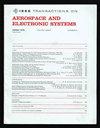非均匀杂波多径环境下的自适应目标检测
IF 5.7
2区 计算机科学
Q1 ENGINEERING, AEROSPACE
IEEE Transactions on Aerospace and Electronic Systems
Pub Date : 2025-04-01
DOI:10.1109/TAES.2025.3556660
引用次数: 0
摘要
本文研究了非均匀杂波和多径分量环境下的自适应雷达探测问题。将非均匀杂波表示为复合高斯模型,将逆高斯纹理与复高斯分布相结合。我们进一步考虑由漫射多径现象引起的多径分量,通过复杂的圆形高斯分布向量建模。采用两步最大后验广义似然比检验和复值Rao检验设计了两个检测器。在检测器的推导中,首先推导检验统计量,然后结合估计的协方差矩阵得到自适应检测器。此外,我们提出了一个可调参数来适应多径环境,使基于glrt的检测器退化为基于逆高斯纹理复合高斯分布的传统检测器。此外,所提出的检测算法是对散斑协方差矩阵的恒定虚警率测试。使用模拟和测量数据的数值实验证实,所提出的检测器在多路径环境中优于竞争对手。本文章由计算机程序翻译,如有差异,请以英文原文为准。
Adaptive Target Detection in Nonhomogeneous Clutter and Multipath Environment
This article addresses the adaptive radar detection within environments characterized by nonhomogeneous clutter and multipath component. The nonhomogeneous clutter is represented as the compound Gaussian model, combining an inverse Gaussian texture with a complex Gaussian distribution for the speckle component. We further consider the multipath component caused by the diffuse multipath phenomena, modeling by the complex circular Gaussian distribution vector. Two detectors are designed by the two-step maximum a posteriori generalized likelihood ratio test (GLRT) and complex valued Rao test. In the derivation for the proposed detectors, the test statistics are derived first, followed by incorporating the estimated covariance matrix to obtain adaptive detectors. In addition, we present a tunable parameter to adapt to the multipath environment in the GLRT-based detector, which may degrade into the conventional detector derived in the inverse Gaussian texture compound Gaussian distribution. Besides, the proposed detection algorithms are constant false alarm rate tests to the speckle covariance matrix. Numerical experiments using both simulated and measured data confirm that the proposed detectors outperform competitors in multipath environments.
求助全文
通过发布文献求助,成功后即可免费获取论文全文。
去求助
来源期刊
CiteScore
7.80
自引率
13.60%
发文量
433
审稿时长
8.7 months
期刊介绍:
IEEE Transactions on Aerospace and Electronic Systems focuses on the organization, design, development, integration, and operation of complex systems for space, air, ocean, or ground environment. These systems include, but are not limited to, navigation, avionics, spacecraft, aerospace power, radar, sonar, telemetry, defense, transportation, automated testing, and command and control.

 求助内容:
求助内容: 应助结果提醒方式:
应助结果提醒方式:


